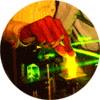 Flow
Cytometry Facility Overview
Flow
Cytometry Facility Overview Flow
Cytometry Facility Overview
Flow
Cytometry Facility Overview The laboratory of Flow Cytometry was
formed in 1988 to provide a cutting edge core facility for the clinical
and basic science investigators at RPCI. The goals of the laboratory
are to provide multiparameter flow cytometry services to basic and clinical
research investigators, provide an educational outreach program in flow
cytometry, and develop new instrumentation to extend flow cytometry applications.
To accomplish these goals, and, as a focal point for many interdisciplinary
activities, the Laboratory of Flow Cytometry is
a multipurpose laboratory that provides both core and
reference laboratory services and maintains an active translational research
program.
CLINICAL REFERENCE SERVICE:
The Flow Cytometry Facility is a licensed reference laboratory for: classification by immunophenoptyping of leukemias and lymphomas; for evaluating immunologically-based diseases; for monitoring transplant patients; and for evaluating DNA in solid tumors. The laboratory is accredited by the Joint Commission on Accreditation of Health Care Organization, the New York State Department of Health, and CLIA. We participate on NYSDOH and CAP proficiency programs, as well as the CDC's MPEP program. The Facility provides clinical research support for protocols that require specific immunophenotyping follow-up to monitor the progress of therapy, and is committed to translational research through development of new tests that will provide insights into cancer patient management.
The immunphenotyping service utilizes panels of three and four antibodies, each labeled with different flurochromes that have been designed to resolve unique cell subsets. Since 1988, 52 three-color panels and 40 four-color panels have been designed to make up screens for classifying leukemias and lymphomas; for monitoring therapy of bone marrow transplant patients; for complete lymphocyte characterization; and, for various other protocol studies. The Facility has pioneered the routine three and four-color immunophenotyping approach that has several practical and scientific advantages over the or tow antibody approach more commonly used. From a practical viewpoint, only 1/3 to one fewer samples need to be processed, using fewer cells. From the scientific viewpoint, cells are best resolved by taking advantage of the unique repertoire of cell surface molecules associated with a particular normal or abnormal cell population.
When cells are labeled with three or four antibodies to determine antigen expression simultaneously, the result is a distinct pattern of cell clusters that takes advantage of the antigen densities on the cell's surface. The pattern for antigen expression on normal cells is very stable and reproducible among individuals. On neoplastic cells, this pattern is very different from any found on normal cells, due to aberrant antigen expression. This may be due to the complete lack of a lineage antigen, improper intensity of expression, or the presence of an antigen usually found on a different cell lineage. Knowledge of the normal and abnormal patterns provides for the definitive diagnosis of hematopoietic malignancy and subsequent follow-up.
The measurement of DNA content by flow
cytometry has been extensively used to determine the degree of anueploidy
in malignant cells, and the percentage of them that are in S-phase.
Hundreds of reports over the last 20 years have demonstrated the importance
of this measurement for the overall evaluation of cancer in combination
with other clinical factors. Because of the increased number of women
getting mammograms that provide for an earlier detection of breast lesions,
very little material is available for testing. Multiparameter flow
cytometry offers the means for measuring several tumor associated markers
and DNA content simultaneously on the same cells using a single tube.
Needle biopsy provides marker enough cells for this evaluation. This
new approach that combines DNA with immunophenotyping ought to significantly
improve the clinical efficacy of flow cytometry in characterizing solid
tumors.
BASIC RESEARCH SERVICE:
In our experience, there are three kinds of scientists who use flow cytometry: those who are already proficient in flow cytometry and who already know its capabilities; those who use flow cytometry as a part of their research program, but depend on the expertise of the flow cytometry staff for providing reliable service; and those who have just learned about flow cytometry or who are just considering the application of this technology to their research problems. We must serve all three of these user groups efficiently, and to do so, we train principal investigators and their technical staff in sample preparation, immunophenotyping and DNA content measurements. They learn how to operate a flow cytometer and to analyze and interpret the acquired data. We charge $35.00 per hour for instrument acquisition time, but data analysis is free. The facility is subsidized by a Cancer Center Research Support Grant from NCI.
Our staff, rather than the user, performs all cell sorting experiments due to the complexity of the instrumentation. We also charge $35.00 per hour for this service. In 1996, we performed over 300 cell sorting experiments for investigators at RPCI as well as for investigators outside the institute. The addition of high speed sorting capability has allowed us to increase our capacity and to perform an average of three sorts per day compared to one sort per day. The reduced sort time has been met with increased user satisfaction because they get their product much faster.
SPACE
In August 1996, the laboratory moved
to new renovated space occupying approximately 4500 sq. ft. This space
consists of two fully equipped research laboratories, a darkroom, a laboratory
for facility users, a clinical reference laboratory and an electronics
laboratory. Offices are also provided for staff, students and guest scientists.
A large conference room is shared with Experimental Pathology.